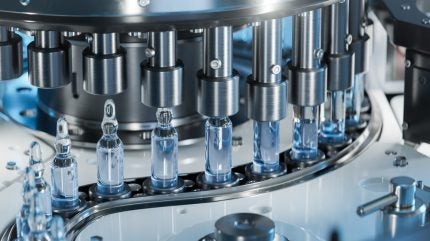

Multiply Labs has developed a robotic biomanufacturing cluster that the company claims can reduce the cost of cell and gene therapy (CGT) manufacturing by 74%.
The modular system achieves this by harnessing the activity of multiple collaborative robot arms, which work in parallel to fully automate the CGT production process. This removes the need for manual intervention, which has traditionally been heavily relied upon during cell therapy manufacturing.

Discover B2B Marketing That Performs
Combine business intelligence and editorial excellence to reach engaged professionals across 36 leading media platforms.
By utilising Universal Robots’ (UR) collaborative robot arms in a floor-to-ceiling arrangement, the system aims to reduce the CGT manufacturing footprint within the cleanroom space, reducing costs and ensuring sanitary production.
The manufacturing process implemented by Multiply’s robot is trained using videos of scientists performing each step manually, meaning they remain consistent with well-known and understood CGT production methods.
Since the technology replicates manual processes that have already been approved, it also overcomes any regulatory hurdles associated with process validation.
Saving costs in the CGT space
Though the CGT concept has been around since the late 1970s, Novartis was the first to make the cell therapy modality a commercial reality, gaining US Food and Drug Administration (FDA) approval for Kymriah (tisagenlecleucel) in 2017.

US Tariffs are shifting - will you react or anticipate?
Don’t let policy changes catch you off guard. Stay proactive with real-time data and expert analysis.
By GlobalDataDespite the sector’s rapid rise to fame following this landmark, developers of this modality have been plagued with troubles post-marketing – with companies struggling to scale up production and keep manufacturing costs down.
This has led Pfizer to discontinue its haemophilia B gene therapy Beqvez (durveqtix), which suffered poor sales due to low uptake. The drug was listed at a price of $3.5m, making it one of the most expensive drugs in history.
“Currently, cell therapy production is very difficult to automate at a larger batch size, as two people cannot get the same product,” Connor Kennedy, Universal Robots’ pharma global segment manager, told Pharmaceutical Technology. “This has made it difficult for companies in the space to justify capital investment in automation.”
Now health tech companies, such as Multiply, are looking to revive the momentum of the CGT space by enabling rapid scaling and – most importantly – reducing manufacturing costs.
According to Kennedy, collaborative robots will enable pharma players to more freely invest in CGTs as they can directly replicate the manufacturing process more quickly and within a smaller footprint, while using traditional equipment.
“Robots will eliminate the need for humans to intervene in CGT production, which means that the process can run 24/7,” Kennedy said. “This type of technology can also save cleanroom space.”
Conserving traditional processes
Though there are a range of companies developing robotics for CGT manufacturing, Kennedy notes that Multiply Labs’ differs due to the collaborative way in which it was developed.
“When creating this biomanufacturing cluster, Multiple worked with its academic partners to come up with a good metric of what current manual processes look like,” Kennedy said.
This allowed the company to employ traditional methods using existing machinery, while incorporating automation to enhance process efficiency. “Multiply identified a manual baseline and established that it could beat that in terms of efficiency and cost,” he added.
The biomanufacturing cluster also uses UR’s Polyscope platform, which is designed to integrate into existing systems. According to Kennedy, Polyscope allowed Multiply to “integrate robots into their path planning process, bringing four co-ordinated robots together inside one cluster.”
Automation’s future in CGT
Moving forward, Kennedy predicts that this technology could take off in as little as five years. “Once companies start investing in CGT manufacturing automation, they can drop their production costs and release new medicines that may not have been commercially viable without it,” he stated.
“Eventually, we could start to see systems like this – or even smaller – deployed for use in hospitals,” said Kennedy. “This would reduce the need for patient samples to be sent to a centralised manufacturing location, further reducing therapeutic costs and improving accessibility to personalised medicine”.
“Increasingly potent small batch products like cell therapies will continue to grow as robotics enables this – making a marked difference in the healthcare system’s ability to treat difficult diseases, rare cancers and genetic disorders,” Kennedy concluded.
Cell & Gene Therapy coverage on Pharmaceutical Technology is supported by Cytiva.
Editorial content is independently produced and follows the highest standards of journalistic integrity. Topic sponsors are not involved in the creation of editorial content.






